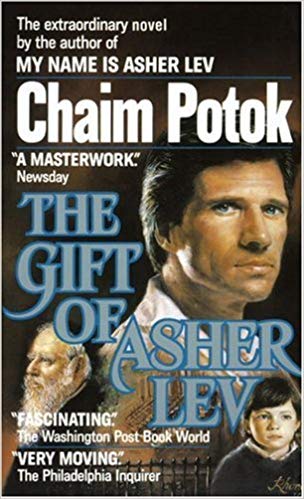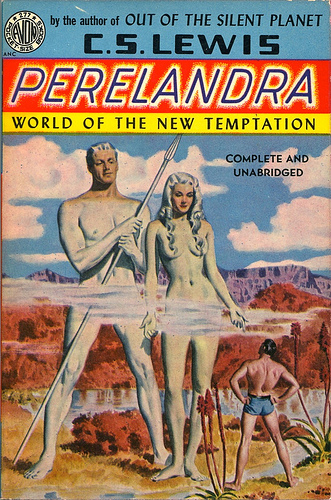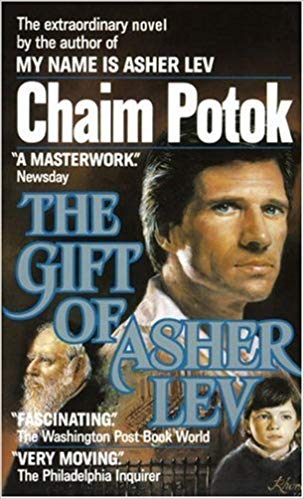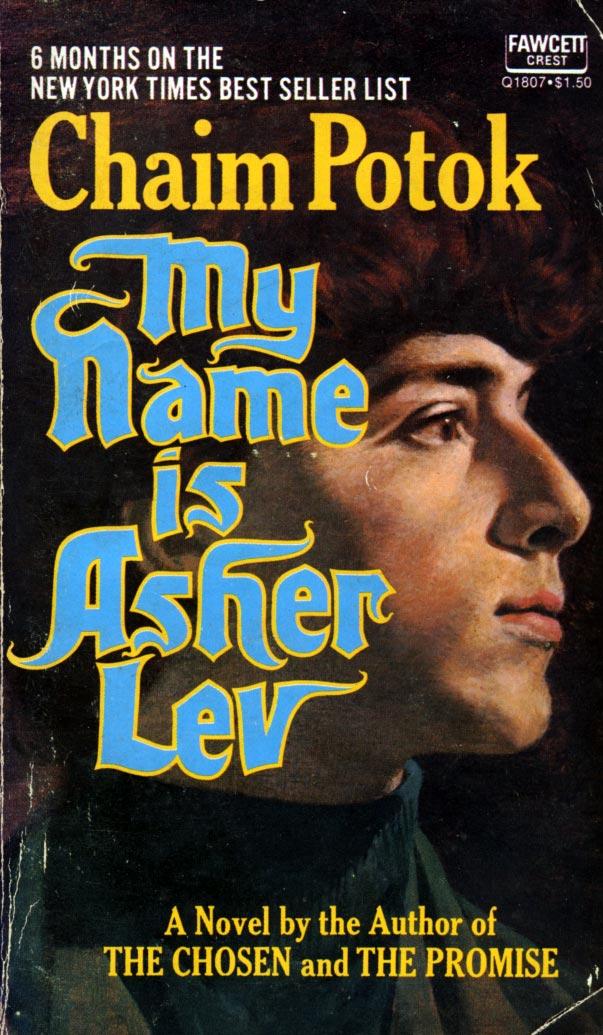I posted on Monday a reflection about my reading of The Gift of Asher Lev, the sequel to Chaim Potok stunning novel, My Name is Asher Lev. Potok’s book really is a “gift,” but I noted some “curse” elements as well. One problematic feature I left out was the book cover.
I know, I have complained of bad book covers before. One of the worst I noted was the book description to C.S. Lewis’ Out of the Silent Planet, but there are some hilarious book covers to Perelandra, including a never-nude superhero-pose Ransom confronting some half white/half green alien elemental beings.
Man, those sexy butt cheeks. Convenient clouds too. Totally Lewis. Absolutely.
But the Gift of Asher Lev cover is not much better. Here is the cover of my copy:
Pretty terrible, isn’t it? I set this sequel to the literary fiction classic My Name is Asher Lev on my bedside table and my wife said, “Oh, now you’re reading trashy novels?” Little could she know, between these trashy covers is a highly sophisticated exploration of faith, love, art, and culture.
Do you get that from the cover?
There are some nicely artistic covers of the Asher Lev series in brash colours:

 In a more etherial vein, there are also these:
In a more etherial vein, there are also these:
As book covers go, these at least capture the essence of the novel. They’re all better than this:
And yet, this last terrible, terrible book cover has one essential truth. Would you have gotten from this survey of paperback covers that Asher Lev was a ginger?
More than that, in youth, Asher’s distinctive red hair was a feature of the novel, and he grew his forelocks (payos) out beside his ears. Later he tucked his payos behind his ears, and then grew a solid, red beard. In the sequel, Asher’s red beard becomes streaked with grey. But it is a constant feature of the book–a gene that is passed on to his little son, Avrumel. Asher’s father’s beard goes white, but he continues to wear his payos, often tucking them behind his ears.
Let’s take a look at this terrible book cover again, looking for a Jewish artist with a large red beard who always wears a fisherman’s cap, his young ginger son with a sweet disposition, and his father with the white payos:
 Well, at least there is a vaguely Jewish looking bearded elder on the cover, just below the Harrison Ford tan-boy doppelgänger staring off into the middle distance and beside the child from Omen.
Well, at least there is a vaguely Jewish looking bearded elder on the cover, just below the Harrison Ford tan-boy doppelgänger staring off into the middle distance and beside the child from Omen.
The anti-ginger element is clear and shocking.
I admit that I have some skin in the game. It isn’t just recent media messages, such as the fact that redheads have genetic superpowers or that there is a ginger pop culture movement afoot, a “gingerenaissance“. It isn’t even that I am from Prince Edward Island, home of Anne of Green Gables, where we are legally required to love redheads. My son is a ginger, and is pretty good at it. As he looks forward to a future as a rock legend, I know that there will be some rough paths ahead.
Now, if I had written a long, detailed, and technical master’s thesis on antisemitism, I might be inclined to also note that the Jewishness on most of these covers is entirely erased or hidden, and the story of Hasidic Judaism is most certainly not at the front of the reader’s mind when going to this shelf–though there is one anti-ginger Hasidic cover, and some vaguely Jewish or European peasant hints in others.
Perhaps an even more important story than anti-ginger bias is the not-so-subtle suppression of Judaism in two of the most Jewish-soaked books I have ever read.
There’s actually a term for this. “Whitewashing” is when publishers present a character of colour as white for marketing purposes. Here is an example that’s pretty classic and well known. This is the copy of the cover of Octavia Butler‘s brilliant and disturbing root novel of the Xenogenesis series, Dawn:
The protagonist is a distinctively black character, though when I was first reading the book it wasn’t something I really noted. When I saw the first edition of the softcover, however, I did a double-take:
Quite beyond the fact that it would be difficult to place this scene in the book at all, this is clearly a case of whitewashing. In this article on Book Smugglers, they take the time to show some examples from different genres (see here). It is a pretty effective visual aid to see a quiet and consistent trend in publishing, including one of my favourite books, Wizard of Earthsea, a brown-skinned magical genius:
There’s a lot to explain about that cover, quite beyond the whitewashing. But it highlights a concern in the industry. More than anti-ginger sentiment–and even more than when they want C.S. Lewis’ green naked gigantic etherial aliens to seem more human so they make their faces white–the publishing industry, like so much of visual culture, seems content to take the colour out of things. I suppose it’s no wonder that so many stories look so pale.
































The ironic thing is that it seems possible that the artist for the Perelandra cover had actually read the novel, and the scene is a poor attempt to visualize a passage from near the book’s end. Perhaps you have seen the Avon paperback of Out of the Silent Planet showing a rocket ship with fins, a burly hero figure, and a glaring green eye — likely enough, it was a piece of generic science fiction art the publisher had lying around.
But the figures on the Perelandra cover look like cardboard images that you could push over.
LikeLiked by 1 person
Hi Dale, you are right about the artlessness. I did a whole blog post years ago about terrible Out of the Silent Planet covers. I do think there is at least SOME connection in this Perelandra cover to the book itself.
LikeLike
That first “Gift of Asher Lev” cover looks like the VHS cover for a late-‘80s/early-‘90s Pierce Brosnan drama in which he struggles to keep custody of his child or something like that.
That “Perelandra” cover, though…on some pulpy absurd space adventure that might be a fun cover, but not for Lewis! Yikes.
As a storyteller myself, illustrations that flatly misrepresent the content really irritate me. “The Wizard of Earthsea” example is one that hits home for me: I discovered the story through an excerpt in one of those excellent Childcraft collections we had around the home in my childhood, but the illustrations for it had the boy Ged in pale skin, blond hair, and probably even blue eyes. It wasn’t till I read the book as an adult that I realized how off it was.
LikeLike
I don’t know the movie, but I can imagine exactly what you are talking about.
And, I suppose “pulpy” is the right word. It is post-pulp era, but the influence is there. I like it in a lot of ways, but none of them are really connected to the story.
Am I strange that I don’t visualize characters well, colour or otherwise? The result is that I’m not surprised when Meg from Swiftly Tilting Planet is black on screen, and Katniss is white. I just don’t code well.
LikeLike
It was more a general vibe that I got from that cover art, but I may have subconsciously had in my mind this movie, even though it is from 2002: https://www.imdb.com/title/tt0298856/
The drawing of Asher Lev looks a bit like Pierce Brosnan to me.
I don’t think it’s strange that you don’t visualize characters very much. I think it just differs per person. I do tend to visualize characters a lot. It helps me to get a general sense of their physical build, their hair, eye, or skin color, and any unique physical features. Helps me situate myself in the world of the story, and the character’s viewpoint. However, I’ve read many successful stories that don’t do this. Interestingly, Tolkien rarely gives such extensive physical descriptions of characters.
LikeLike
Good point about Tolkien and visualization. I was thinking of Lewis, and he mostly only describes like that to either mock a character or draw out a core characteristic.
LikeLike
I think Dale Nelson is correct that “it seems possible that the artist for the Perelandra cover had actually read the novel, and the scene is a poor attempt to visualize a passage from near the book’s end” – I can’t remember how ‘Piebald’ was or was not clothed at what point, but the illustration strikes me as bringing home one interesting feature of the book, which we can imagine Lewis savouring: its effective undramatizability, whether on stage, in film with live actors or as cartoon, and perhaps its effective undepictablility, given all the (unsexy) nudity. I wonder if Lewis was acquainted with Tolkien’s ‘On Fairy-stories’ (as text or report) by the time he wrote it, and was conscious of favouring verbal story telling as Tolkien does there?
It is very weird how often it seems the cover-illustrator has not read the book, or seems perversely to ignore what he does know (the latter being something many adaptors exhibit as well). (One thinks of the Monty Python skit about 28 disciples in a too-grandiose painting of the Last Supper…)
Can you tell us more about the Asher Lev covers the seem to show some existing painting – and about the two other illustrations in your preceding post?
LikeLike
I can understand that illustrators can’t afford the book-reading time. But a great summary would take 15 minutes. Maybe 20. A secretary or local nerd could do it.
LikeLike
I don’t know why so few of Chaim Potok’s works have been dramatized (having loved the film version of The Chosen), but I see there’s lots of stuff on YouTube relating to various productions of Aaron Posner’s stage adaptation of My Name is Asher Lev – which might give an interesting tangent to the matter of this post…
LikeLike
I didn’t see The Chosen. I think that Asher Lev is a bad film adaptation: You can describe genius art, but you can’t show it.
LikeLike
Some of those covers are totally lacking in taste if nothing else. I get annoyed when I look at a cover then read the book only to find that the character portrayed on the cover looks nothing like the actual description in the book. That’s why I like to design my own book covers. I get what I want without any argument or constant changes to get it right.
LikeLike
I don’t know any time when those Asher Lev middle-distance covers were tasteful.
LikeLike
More books on my “would like to read” list, even before I read your post…
I think the cover problem could probably be solved by the publishers requiring the cover artists to read the books for which they are designing the covers, especially novels. Guess that would take too much time, and time is money…
“Ginger bias”… My church building, like most classical Orthodox churches, has real frescoes on the walls. Some subjects, and their placement in the space, are standard for church interiors. The optional subjects that are chosen by parishioners are mostly figures of saints, our “older brothers and sisters in the Lord.” While thinking about how to approach the depiction of Esther, our fresco artist was ruminating on what it might have been about her that caused Ahasueros to choose her out of the line-up of beautiful girls. He surmised that, like some Jews (and I’ve known a few myself) she would have had red hair that turned the King’s head – so he painted her with auburn/mahogany locks.
Dana
LikeLike
I suppose that the pro-redhead moment is certainly growing more quickly than the anti-Ginger bias!
Yes, if the artists read the book…. Of course, they might read badly.
So many great books to read!
LikeLike
https://www.tor.com/2019/08/20/from-the-two-rivers-casting-and-race-in-the-wheel-of-time/
Similar issues being raised on tor.com re the book covers for Jordan’s ‘Wheel of Time’, something which really only became obvious when they started casting for a TV series based on the books.
LikeLike
Thanks for that note!
LikeLike
Yes, thanks – and for tangentially occasioning my embarking on Matt Mikalatos’s Narnia series, over there!
LikeLiked by 1 person
Just learnt about Barnes & Noble’s “Diverse Editions project” on the occasion of their deciding “to suspend the initiative”.
LikeLike
I didn’t know they suspended it, but it was pretty hilarious.
LikeLike
Pingback: The World as a “Vale of Soul-Making”: A Brief Note on John Keats, C.S. Lewis, and L.M. Montgomery | A Pilgrim in Narnia